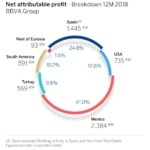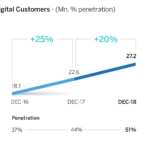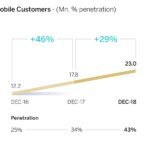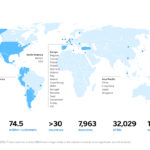BBVA earns €5.32 billion in 2018, up 51.3 percent yoy
- Transformation: More than half of BBVA customers are digital, meeting the target set for 2018
- Income: Operating income grew 6.2 percent at constant exchange rates, thanks to the increase in recurring revenues and cost discipline
- Risks: BBVA showed strength in risk indicators, with an NPL ratio declining to 3.9 percent, and a coverage ratio of 73 percent
- Solvency: At the end of December, the fully-loaded CET1 ratio stood at 11.3 percent
- Shareholder value creation: The tangible book value per share plus dividends grew 10.1 percent in 2018, while the ROE increased to 11.6 percent
- Dividend: A cash payment in a gross amount of €0.16 per share, to be paid in April as final dividend for 2018, is expected to be proposed for the consideration of the competent governing bodies

In 2018, the BBVA Group earned €5.32 billion, 51.3 percent more than in the previous year. Recurring revenues, cost containment efforts, and capital gains on the sale of BBVA Chile drove these results. BBVA’s diversified model and the transformation strategy are behind this positive evolution and of the improvements in efficiency.
“Despite a complex environment, we’ve managed to post very good results, a double-digit profitability, while making significant progress in our transformation process,” said BBVA Group executive chairman Carlos Torres Vila.
Net interest income stood at €17.59 billion in 2018, up 10.8 percent at constant exchange rates (-0.9 percent at current exchange rates), while net fees and commissions reached €4.88 billion in the year, up 8.9 percent (-0.8 percent at current exchange rates.) Combined, both lines, which account for the most recurring revenues, reached €22.47 billion, 10.4 percent more (-0.9 percent at current exchange rates).
The BBVA Group maintained its cost discipline across all geographies. In constant terms, operating expenses increased 2.5 percent throughout the year, well below the average inflation recorded in the different countries of BBVA’s footprint. At current exchange rates, these costs decreased 6.4 percent. The favorable relationship between recurring revenues and operating expenses across all geographies improved the efficiency ratio by 89 basis points, to 49.3 percent in 2018 (at constant exchange rates). The good performance of recurring revenues and the containment in operating expenses accounted for a 6.2 percent increase in operating income to €12.05 billion at constant exchange rates (-5.7 percent at current exchange rates).
The BBVA Group’s net attributable profit reached €5.32 billion in 2018, up 51.3 percent yoy at current exchange rates (+78.2 percent at constant exchange rates). This increase includes the result generated by net capital gains on the sale of BBVA Chile (€633 million) in the third quarter. In constant terms, it is worth noting the positive performance of the most recurring revenues, lower loan-loss impairments -following the negative impact from BBVA’s stake in Telefonica in 2017- as well as provisions, which have more than offset a lower contribution from net trading income (NTI) compared to the same period a year earlier.

Profitability indicators saw double-digit growth, with ROE increasing significantly to 11.6 percent in the year and ROTE reaching 14.1 percent. Leaving out the capital gains from BBVA Chile, those items stood at 10.2 percent and 12.5 percent, respectively. In 2018, the tangible book value per share plus dividends per share reached €6.11, up 10.1 percent yoy. Also, It is expected to be proposed for the consideration of the competent governing bodies a cash payment in a gross amount of €0.16 per share to be paid in April 2019 as final dividend for 2018.
As for risk indicators, the NPL ratio stood at 3.9 percent as of December 31, 2018, 19 basis points lower than Q3-18 and 61 basis points less in the whole year. The coverage ratio closed at 73 percent and the cumulative cost of risk for the year stood at 1.01 percent. In 2018, the Group continued to reduce its NPL balance, on the back of a good performance of banking activity in Spain.
In terms of solvency, BBVA maintains a solid capital position, above regulatory requirements. The fully-loaded CET1 ratio closed the year at 11.3 percent. The fully-loaded leverage ratio stood at 6.4 percent, the highest among its comparable European peer group. In order to be better prepared for future regulatory requirements, BBVA considers reasonable to increase the target of its full-loaded CET1 ratio to a range from 11.5 percent to 12 percent. The Group expects to reach that range at the end of this year, keeping intact its shareholder remuneration policy, with a cash payout between 35 percent and 40 percent.
Regarding the balance sheet and the business activity, the year-on-year comparison is affected by the sale of BBVA Chile, completed in July 2018. In net terms, loans and customer advances stood at €374.03 billion, in line with figures from a year earlier, while customer deposits amounted to €375.97 billion (up 3.4 percent). In off-balance-sheet funds, mutual funds continued their good performance.
Transformation
In 2018, BBVA surpassed a new milestone in the digitization of its customer base. At year end, over half (51 percent) of its customers were banking through digital channels. Mobile customers now account for 43 percent of the total and the goal for 2019 is to reach the 50-percent mark. Total unit sales through digital channels represented 41 percent of the total, compared to just 16 percent two years ago.


The main highlights of each business area are detailed below.
Regarding Banking Activity in Spain, lending remained in line with 2017 figures (-0.7 percent), with a solid performance of consumer financing and credit cards (+21.9 percent) and very small businesses (+6.5 percent). The mortgage portfolio fell but at a slower pace (-3.6 percent) than last year, as well as a drop in the public sector. Customer funds grew 2.9 percent throughout the year, driven by demand deposits.
As for results, net interest income fell 1.8 percent in the year (although it grew 1.2 percent in Q4-18), but it was offset by a 7.7 percent increase in net fees and commissions. As a result of lower operating expenses (-3.8 percent yoy), lower impairment losses (-34.6 percent yoy) and declining provisions (-20.9 percent yoy), the net attributable profit grew 10.8 percent to €1.52 billion yoy. NPLs showed a declining trend throughout the year that benefitted the NPL ratio, which declined to 4.6 percent, from. 5.5 percent in December 2017. The coverage ratio increased from 50 percent to 57 percent over the course of the year.
In the Non Core Real Estate area, net exposure to real estate declined to all-time lows as a result of the transfer of BBVA’s real estate business in Spain to Cerberus, last October. Also, BBVA and Canada Pension Plan Investment Board signed an agreement in July for the sale of a portfolio of non-performing and written-off loans to developers, with a gross value of €1 billion.
As of December 31, 2018, BBVA’s real estate net exposure stood at €2.5 billion, which represents a very significant drop of 61.1 percent yoy. In 2018, the Non Core Real Estate area presented a negative cumulative result of €78 million, compared to €490 million in losses the previous year.
The net attributable income in Spain in 2018, including Banking Activity and Non Core Real Estate areas, stood at €1.45 billion, up 63.4 percent from a year earlier.
In the United States, lending increased 7.4 percent yoy, supported by consumer financing and cards (+28.2 percent), SMEs loans (+2.9 percent) and corporates (+12.3 percent). Customer funds remained in line with the figure for December 2017 (+0.3 percent). Net attributable profit for 2018 reached €735 million, up 56.9 percent yoy in constant terms (+51.3 percent at current exchange rates). This growth was driven by the favorable performance in net interest income (+12.1 percent stripping out currency fluctuations), lower impairments losses and provisions, and a reduction in the effective tax rate. The NPL ratio stood at 1.3 percent, while the coverage ratio reached 85 percent.
In Mexico, lending grew by 8.1 percent in constant terms, thanks to a good performance of the wholesale portfolio (+9.2 percent), driven by medium-sized companies and the corporates segment, as well as the retail portfolio, mostly supported by consumer loans (+8.7 percent). Total customer funds increased 3.6 percent yoy. The area achieved a net attributable profit of €2.38 billion, up 16.1 percent yoy at constant exchange rates (+9 percent at current exchange rates). This growth was supported by the net interest income (+8.2 percent) and net fees and commissions (+5.1 percent), both at constant exchange rates. The NPL ratio stood at 2.1 percent, while the coverage ratio reached 154 percent.
In Turkey, loan portfolios in local currency grew 3.7 percent in 2018, following a slowdown in the second half of the year. Garanti continued to cut its exposure to foreign-currency loans (in U.S. dollars), with a reduction of 19.3 percent, in line with its strategy. Customer funds denominated in U.S. dollars fell 14.4 percent, while those in Turkish lira increased 15.8 percent. In a complex year, Garanti was able to generate an operating income (+40.9 percent yoy in constant exchange rates), with the ability to absorb the increase in provisions as a result of the deterioration of the macro economic environment. Excluding currency exchange fluctuations, both the net interest income (+30.3 percent) and net fees and commissions (+35.1 percent) significantly contributed to the results. Net attributable profit for the area was €569 million in the year, down 4.5 percent yoy (-31 percent in current exchange rates) The NPL ratio increased to 5.3 percent (compared to 3.9 percent a year earlier) as a result of the economic scenario, while the coverage ratio declined from 85 percent to 81 percent.
In South America, it is worth noting the sale of BBVA Chile, completed in July 2018. Excluding BBVA Chile, loans to customers grew 8.6 percent in the year (at constant exchange rates) and customer funds increased by 10.5 percent. The year in South America ended with a net attributable profit of €591 million, down 16.5 percent yoy (-31.3 percent at current exchange rates). The performance of the net attributable profit was affected by the impact of hyperinflation in Argentina (€-266 million) and the change in perimeter resulting from the sale of BBVA Chile. The NPL ratio stood at 4.3 percent, while the coverage ratio reached 97 percent.
About BBVA

BBVA is a customer-centric global financial services group founded in 1857. The Group has a strong leadership position in the Spanish market, is the largest financial institution in Mexico, it has leading franchises in South America and the Sunbelt Region of the United States; and it is also the leading shareholder in Garanti, Turkey’s biggest bank for market capitalization. Its diversified business is focused on high-growth markets and it relies on technology as a key sustainable competitive advantage. Corporate responsibility is at the core of its business model. BBVA fosters financial education and inclusion, and supports scientific research and culture. It operates with the highest integrity, a long-term vision and applies the best practices.